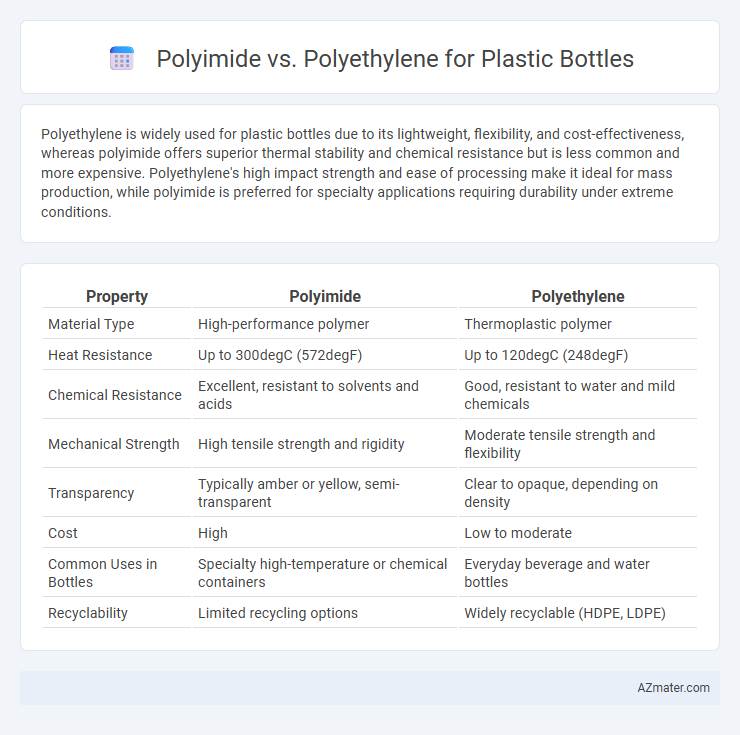Polyethylene is widely used for plastic bottles due to its lightweight, flexibility, and cost-effectiveness, whereas polyimide offers superior thermal stability and chemical resistance but is less common and more expensive. Polyethylene's high impact strength and ease of processing make it ideal for mass production, while polyimide is preferred for specialty applications requiring durability under extreme conditions.
Table of Comparison
| Property | Polyimide | Polyethylene |
|---|---|---|
| Material Type | High-performance polymer | Thermoplastic polymer |
| Heat Resistance | Up to 300degC (572degF) | Up to 120degC (248degF) |
| Chemical Resistance | Excellent, resistant to solvents and acids | Good, resistant to water and mild chemicals |
| Mechanical Strength | High tensile strength and rigidity | Moderate tensile strength and flexibility |
| Transparency | Typically amber or yellow, semi-transparent | Clear to opaque, depending on density |
| Cost | High | Low to moderate |
| Common Uses in Bottles | Specialty high-temperature or chemical containers | Everyday beverage and water bottles |
| Recyclability | Limited recycling options | Widely recyclable (HDPE, LDPE) |
Introduction to Polyimide and Polyethylene
Polyimide is a high-performance polymer known for its exceptional thermal stability, chemical resistance, and mechanical strength, making it suitable for demanding applications such as aerospace and electronics. Polyethylene, on the other hand, is a widely used thermoplastic characterized by its flexibility, low cost, and excellent moisture barrier properties, commonly found in everyday plastic bottles and packaging. Comparing the two, polyimide offers superior durability and heat resistance, while polyethylene excels in cost-effectiveness and ease of processing for mass production.
Chemical Structure Comparison
Polyimide features aromatic rings linked by imide groups, creating a rigid, thermally stable polymer with strong chemical resistance ideal for high-performance applications. Polyethylene, composed of long chains of repeating ethylene units with simple C-C and C-H bonds, offers flexibility and chemical inertness but lower thermal stability. The imide functional groups in polyimide contribute to superior mechanical strength and thermal resistance compared to the saturated hydrocarbon structure of polyethylene commonly used in standard plastic bottles.
Mechanical Properties Overview
Polyimide exhibits superior mechanical strength, high thermal stability, and excellent chemical resistance compared to polyethylene, making it ideal for high-performance plastic bottle applications. Polyethylene offers good flexibility, impact resistance, and cost-effectiveness but has lower tensile strength and thermal tolerance than polyimide. Mechanical properties such as tensile strength of polyimide can exceed 100 MPa, whereas polyethylene typically ranges between 20-40 MPa, influencing durability and lifespan in harsh environments.
Thermal Stability Differences
Polyimide exhibits exceptional thermal stability, maintaining integrity at temperatures above 300degC, making it ideal for high-heat applications in plastic bottles. In contrast, polyethylene has a significantly lower melting point, around 120-135degC, limiting its use to ambient or moderately heated liquids. This thermal disparity impacts the choice of plastic material based on temperature resistance requirements in bottle manufacturing.
Barrier Properties for Liquids and Gases
Polyimide exhibits superior barrier properties compared to polyethylene when used for plastic bottles, effectively limiting the permeation of gases like oxygen and carbon dioxide, which helps in preserving the freshness and extending the shelf life of liquids. Polyethylene, while widely used for its flexibility and cost-effectiveness, has higher permeability to gases and moisture, making it less ideal for applications requiring stringent barrier performance. The chemical structure of polyimide, characterized by aromatic and imide linkages, provides exceptional resistance to gas diffusion, making it a preferred material in high-barrier liquid packaging applications.
Impact on Bottle Longevity
Polyimide offers significantly enhanced thermal stability and chemical resistance compared to polyethylene, contributing to prolonged bottle longevity under extreme conditions. Its superior barrier properties reduce gas permeability, minimizing oxidation and spoilage inside the bottle. Polyethylene, while cost-effective and flexible, tends to degrade faster and is more susceptible to environmental stress cracking, leading to shorter bottle lifespan.
Suitability for Food and Beverage Packaging
Polyimide offers superior thermal stability, chemical resistance, and barrier properties, making it highly suitable for food and beverage packaging where long shelf-life and safety are critical. Polyethylene, especially HDPE and LDPE variants, provides excellent moisture barrier, flexibility, and is widely approved for food contact but has lower thermal resistance compared to polyimide. For applications requiring high temperature endurance and resistance to aggressive chemicals, polyimide is preferred, while polyethylene remains a cost-effective, widely accepted option for everyday beverage containers.
Environmental Impact and Recyclability
Polyimide offers exceptional thermal stability and chemical resistance, making it less prone to degradation during recycling compared to polyethylene, which is widely recycled but often contributes to microplastic pollution due to lower chemical resistance. Polyethylene's high recyclability and established global recycling infrastructure reduce environmental impact, but its production relies heavily on fossil fuels and generates significant greenhouse gas emissions. Polyimide, although less recyclable at scale, has potential for durable reuse applications, decreasing single-use plastic waste and promoting sustainability in niche markets.
Cost-Effectiveness Analysis
Polyethylene dominates the plastic bottle market due to its low production cost and high availability, making it a more cost-effective choice for mass production. Polyimide offers superior thermal stability and chemical resistance but incurs significantly higher material and manufacturing expenses, limiting its use to specialized applications. Cost-effectiveness analysis reveals polyethylene's affordability and scalability outweigh polyimide's performance benefits in typical beverage packaging scenarios.
Choosing the Right Material for Plastic Bottles
Polyethylene (PE) is widely used for plastic bottles due to its excellent chemical resistance, low cost, and flexibility, making it ideal for everyday beverage containers. Polyimide, though more expensive, offers superior thermal stability, mechanical strength, and barrier properties, suitable for high-performance applications requiring durability and heat resistance. Choosing the right material depends on the bottle's intended use, with polyethylene favored for mass-produced, lightweight bottles and polyimide preferred in specialty packaging demanding enhanced thermal and chemical robustness.

Infographic: Polyimide vs Polyethylene for Plastic Bottle
 azmater.com
azmater.com